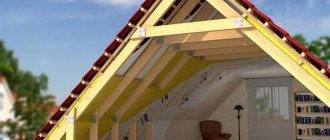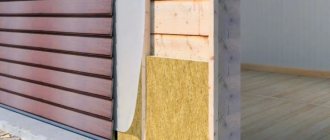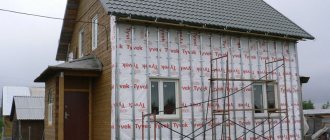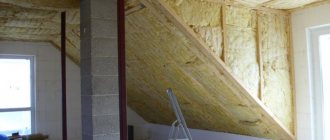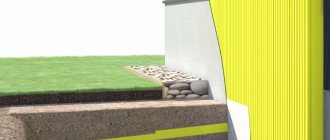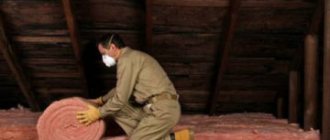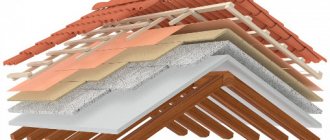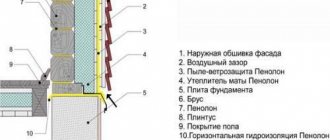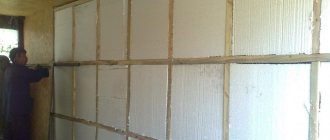Experts are quite ambivalent about the option of insulating a house from the inside of the walls. Most often, this method is considered as an alternative if for some reason it is not possible to insulate the house from the outside. In any case, it is not recommended to insulate a house from the inside without the necessary qualifications. If there is no clear understanding of how to insulate the walls of a house from the inside, then mistakes in choosing insulation and vapor barrier materials are guaranteed to lead to the constant formation of condensation, which will cause the spread of fungus and mold in the walls.
The general principle of work is unchanged - the sheathing and insulation is attached between its joists Source in.pinterest.com
Basic principles of internal thermal insulation
The correct choice of thermal conductivity of insulation makes work on internal insulation as effective as creating an external thermal layer, provided that the heat barrier is correctly placed.
Not every heat-insulating material is suitable for insulating a house from the inside. It must meet certain properties to achieve the assigned tasks:
- Low permeability.
- No secretions harmful to human health.
- Waterproof.
- Ability to maintain configuration under mechanical loads.
It is important to know! The vapor permeability of insulating materials should decrease, that is, the insulation must provide more reliable protection for vapor than a wall. This purpose guarantees the free exit of moist air through the thickness of the wall to the outside.
To avoid problems with insulation from the inside, first of all, you need to determine the location of the dew point. Its correct position should be in the wall or insulation, but not at the junction between them.
Changing the location of the dew point Source mynovostroika.ru
If this happens, then the accumulation of moisture and, as a result, rot, mold and mildew on the surface is inevitable. This situation is possible due to the large thickness of the insulation, since the wall is completely insulated from internal heat.
This also happens as a result of low vapor permeability. Walls made of brick and concrete are especially susceptible to this phenomenon. In this regard, internal thermal insulation in such houses is justified only in non-alternative options.
But in buildings made of timber or logs, such a layer of insulation is quite acceptable; you just need to maintain a gap between the wall and the insulation. Therefore, in order to meet all the requirements for internal insulation, you must first make a frame on the wall from a vertically located beam along the width of the insulation size.
Then a waterproofing film is spread and secured along the wall and insulation material is placed between the slats. It, in turn, is fixed with transverse strips and then a vapor barrier film is stretched on top.
When walls are insulated internally, such a “pie” is created Source moydom-irk.ru
Why do you need to do it?
A certain amount of thermal energy and moisture is always released in the premises, and this is explained by the continuity of human life processes.
Heat is released during cooking, the operation of household appliances, etc. The level of moisture in the air changes after daily washing, boiling water, mopping floors and other activities associated with the use of liquid. Note that the air temperature determines its ability to retain moisture.
If the walls are poorly insulated, the cooled air leaves condensation on their surface. Water settled on the walls becomes a source of fungal mold, which threatens the health of the human body. Mold spores enter the respiratory system and cause asthma or allergies. In addition, the fungus destroys the materials used for the construction of walls and spoils the appearance and quality of clothing.
To get rid of such problems, insulation is installed inside a brick house. In this case, the walls made of brick stone cease to maintain contact with the warm air currents in the room, and therefore there is a possibility of them freezing to the point of contact with the layer of thermal insulation. This means that the insulation efficiency will be low.
A completely different result is achieved if the thermal insulation is placed outside, but sometimes situations arise when such solutions are not possible to implement.
So, the internal surfaces of the walls are insulated in the following cases:
- if there is no permission to change the architecture of the facade walls of the facility;
- expansion joints are made along the external walls;
- walls separate technical premises, elevator shafts and other objects that do not have access for installing a heat-insulating layer;
- The design assignment involves the arrangement of internal insulation for brick walls.
Types of materials and selection criteria
In order to avoid problems during the further operation of the house, you need to choose the right insulation. In addition to physical properties, it also has mechanical parameters. Within this characteristic, the following materials are determined for insulating walls inside the house :
- Mineral wool is a product produced in rolls, produced in different thicknesses.
- Bulk insulation is a material in the form of polystyrene foam granules, has a different configuration and size.
- Foam blocks are insulation, which includes foamed concrete, sand, bone glue and pine rosin.
- Plates are insulating material in the form of plates, which are made by pressing and gluing and have different sizes and thicknesses.
Internal wall insulation with slab heat insulator Source teplostroy.by
See also: Catalog of companies that specialize in insulating country houses.
Interior design - decorative stone in the bathroom
Decorative stone for walls, as a material with high resistance and strength, can also be used in bathrooms. An original decoration will make your daily hygiene area look like an elegant SPA salon. Decorative stone can be freely used as a detail or decorate the entire wall. Just be sure to check before installing the material in a flood-prone area, such as behind a faucet, that the decorative stone model you choose is suitable for that use.
Selection Criteria
Before you insulate the walls from the inside in a private house, you need to get acquainted with the parameters by which these materials are divided. First of all, you need to know the following features:
- Thermal conductivity . It should be low enough.
- Weight . Lightweight products do not require additional fastening.
- Vapor permeability . The higher this property of a material, the more effective its use, since less moisture penetrates and the walls remain drier.
- Possibility for further finishing.
And also, it must have a long service life, allowing replacement no more than once every 12-14 years.
Application of mineral wool
The technical characteristics of this material today allow us to consider it one of the most popular insulation materials. Its main advantage is its low cost and low degree of thermal conductivity.
And also an undeniable advantage of mineral wool is its versatility. It can be applied to any uneven surfaces of any shape: roofs, ceilings, non-standard openings in walls.
All work with mineral wool must be carried out in protective clothing Source skmig.ru
Mineral wool is divided into three types:
- Basalt.
- Slag-like.
- Glass wool.
All varieties of this insulation are united by one property: due to the interweaving of fibers, air spaces are formed inside it, providing a low level of thermal conductivity.
It is important! Mineral wool easily absorbs moisture, so it is recommended to use it as insulation inside the house only in addition to the outer insulating layer.
We insulate the walls from the inside using polystyrene foam
When choosing between mineral wool material and expanded polystyrene, you need to keep one nuance in mind. This insulation has low vapor permeability, so it is not recommended to use it on walls with high vapor permeability (timber, logs, porous concrete).
It will be more effective to use for thermal insulation of brick walls and blocks with low moisture permeability. An adhesive mixture is used to glue this material.
When fixing the insulation, in addition to glue, special nails with heads are used.
Special fasteners with wide caps for insulation materials Source pro-uteplenie.ru
Installation of slabs is carried out sequentially in several stages:
- The surface is being prepared. Cleaned, primed and marked with beacons.
- A rail is fixed at the bottom to support the PPS sheets so that there is no displacement during connection.
- Apply glue to the surface of the wall and the plane of polystyrene foam.
- Apply, align and glue the insulation sheets. It is recommended to do this some time after applying the glue.
- The slabs are additionally secured with nails. They are driven in so that the caps are slightly recessed into the polystyrene foam.
- Then a mesh is applied to the slabs, and the surface is treated with plaster mortar with finishing rubbing. After drying, the panels are ready for further finishing: painting or wallpapering.
On a note! Despite the fact that internal thermal insulation is positioned as an alternative to external insulation in bad weather conditions, insulation of walls inside the house is recommended in the summer when the partitions are heated and in the absence of precipitation.
When is it necessary to insulate inside?
to insulate walls made of panels inside a house when external thermal insulation has proven to be ineffective . In addition, it is not always possible to carry it out, for example, installation of insulation from the outside cannot be carried out if the house is a panel high-rise, or the walls border technical spaces, for example, an elevator shaft.
Reasons for insulating walls from the inside:
- The apartment is corner. In such a room, a large area of the walls comes into contact with frosty air, which is why it warms up worse and cools down quickly.
- Due to high heat loss, mold begins to grow in the corners of the walls.
- There is no external insulation, or it does not cope with its main task.
- The apartment is located on the ground floor or on the basement, which is why it is always cold in it.
If the panels quickly give off heat, then heating devices will not be able to cope with maintaining a comfortable temperature inside the room. At the same time, costs for heating, gas or electricity will increase. Frozen walls are the source of many troubles, ranging from mold to colds.
When is this not needed?
to insulate panel walls if the building has high-quality external thermal insulation .
This means the dew point does not move closer to the living space, and the wall does not freeze. The dew point is understood as the conditional boundary at which water vapor cools to the condensation temperature. This is especially true during the cold season.
If the cooling is below the dew point, then the process of vapor condensation starts : the windows begin to fog up, and the room becomes damp. However, if the house is built and insulated according to the standards, then the dew point will pass through the center of the facade panel and it will always be warm inside the building.
Stages of work
First of all, before insulating the walls of a house internally, it is important to know that the dew point will change - the place where moist air turns into condensation.
Consequently, if you choose the wrong material or its thickness, then such insulation can worsen the condition of the walls: mold, mildew, or destruction of the partition will appear.
It is important! In order to avoid irreparable mistakes, it is better to entrust all calculations for choosing insulation, as well as installation work, to specialists from a trusted construction company.
Before starting work on wall insulation, certain rules must be followed:
- Remove old coatings to the base of the surface, clean, remove possible formations of mold or mildew.
- Treat the wall with an antiseptic and primer solution. At the same time, give each coating a chance to dry.
- When using polystyrene foam, plaster the surfaces with the placement of beacons, which will allow for a more even plane. Allow to dry for at least two days.
- Laying the material.
- Finishing the wall.
Methods for insulating apartment walls in a panel house
The panels differ from brick walls in their low degree of resistance to sudden temperature changes. Frost, like heat, has an adverse effect on the concrete surface of the walls in a panel house: in winter they freeze, and in summer condensation appears on them, causing the formation of mold.
The result may be damage to the decorative finishes inside the room, as well as deterioration of health under the influence of fungal spores.
There is a way out of this situation - it is necessary to insulate the concrete surface of the walls. In theory, this can be done from the outside or from the inside. Before choosing one option or another, you need to consider a number of factors:
- area of the room requiring thermal insulation,
- accommodations,
- number of floors,
- price.
It is almost impossible to carry out external thermal insulation of walls in an apartment panel building yourself. The laying of heat-insulating materials on the outside of the building must be carried out by professionals with permission to work at heights and the necessary equipment.
The cost of such work is quite high, so many residents opt for internal insulation.
The process of thermal insulation of the internal surface of floors also has its own difficulties:
- Laying the heat-insulating layer and finishing leads to a reduction in the area of the room by 80-100 mm;
- During the period of work, the rooms are not available for their intended use;
- After laying the heat insulator, the walls and the heating system are isolated from each other. This phenomenon provokes the accumulation of condensation, due to which fungus can develop.
Video description
Insulation instructions in the following video:
Advice from professionals
When carrying out such work, you need to pay attention to the following points:
- Vapor barrier will help if you make a hermetically sealed joint at the seams.
- The thermal insulation layer should not have a high vapor permeability parameter. In the case where this indicator is higher near the wall than that of the insulating material, steam will escape outside.
- To achieve complete adhesion of polystyrene foam to the wall, the beacon method of applying plaster and the method of leveling the glue with a comb are used. This allows air bubbles to pass between the wall and the insulation.
On a note! To prevent moisture from appearing on the walls, a high-quality ventilation system must be installed in the house - hoods and valves on the windows.
Natural ventilation must be calculated no less carefully than forced ventilation Source sovet-ingenera.com
Dew point concept
By this concept it is customary to understand the boundary of a surface with certain temperature indicators at which any substance acquires a different state.
If when setting the freezing and boiling points everything is simple: in the first case, water becomes ice, and in the second it takes the form of steam, then in the case under consideration, moisture condensation occurs.
This value is extremely mobile, since it is influenced by many factors, namely:
- Atmosphere pressure,
- relative humidity both outside and inside the house,
- actual temperature.
In simpler words, based on information about the level of relative humidity, it is necessary to calculate the limiting temperature values at which condensation forms.
The correct calculation of the presented indicator is directly related to the insulation of housing.
Without taking this value into account, the risk of fruitless costs for the purchase and installation of thermal insulation material, under which moisture will accumulate, increases.
“Crying” walls will ultimately result in the appearance of mustiness in the premises, fungal deposits and mold.
